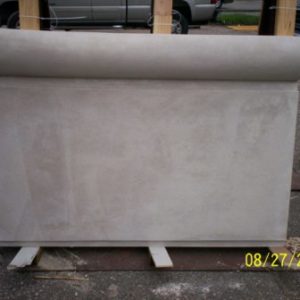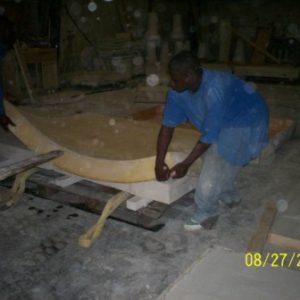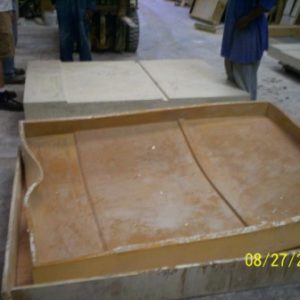I had posted earlier about some precast concrete panels that I was having a problem with, and I was at the precast yard yesterday and took some pictures that might be of interest. These pictures are basically of the moulding process. Sorry for the quality, there was a little dust floating in the air and it was reflecting off the flash. And I don’t have irfan on the office pc, so I have to use some microsoft picture program to shrink the files, and they have preset sizes.
They first build an exact copy of the finished product in wood (I don’t have a picture of that) and then cast a urethane mold of it. This urethane mold is about an inch thick, and is placed in a 3/4″ plywwod box to give it some rigidity when the concrete is poured. The day after it is cast, the urethane mold is stripped off.
This is one of the finished panels. It has problems: you can see lighter areas on the left side of the panel. What you can’t see is a rough texture on the bullnose. This panel is about 3-1/2 feet high and 5 ft wide.
Here are a couple of panels laying in the shed curing. You can see two embedded coil inserts that will be used to lift the panel into place.
Here is one of the urethane mlds, in the plywood box.
For some of the panels, the only difference is the length, so they make the mold the maximum size and then use a moveable divider to cast the right length. The divider is caulked to the urethane to keep the cement from seeping out. This is tha mold for the completed panel in the first picture.
Here are two of the shop guys wrestling the urethane mold off the concrete. It is cast face down, and they use a forklift to flip it over to be unmolded. The corners of the urethane come up pretty easily, but there’s quite a bit of suction in the middle of the flat panel.
Here’s that same panel with the urethane off. You can see the plywood box under the urethane, and the finished panel behind it. They had a problem with the first batch of panels because the straight reveal kept spalling when the urethane was pulled off. The changed the revel so it was slightly tapered (about 8 degrees) and now it comes off cleanly. This panel was rejected due to bad honeycombing that you can’t see in the picture.
And if you don’t build the mold properly, you won’t get a good panel. The plywood mold was built with a 1″ hump in the middle of one end. Had to scrap two panels.
“Put your creed in your deed.” Emerson
“When asked if you can do something, tell’em “Why certainly I can”, then get busy and find a way to do it.” T. Roosevelt
Edited 8/28/2007 11:04 am ET by FastEddie


























Replies
Nice pics. I did a building with cast stone (basically precast with a smoother finish), and there were something like 180 differently shaped panels, column halves, headers, etc., totalling almost 1,000 pieces of cast stone. We visited the plant to check the quality, and what impressed me most was the formwork. They did everything in plywood with a sprayed epoxy coating to cast against, and these guys were incredible carpenters- you couldn't find a flaw in those panels anywhere.
Bob
It seems to me that the shop you are using is having a lot of quality control issues is that normal? and what do they do with all the rejected panels? must be a pile of them. Is this why you are having to ride herd on them.
This precast shop has been used by the gc many times in the past, with good results. In fact, the window sills and headers he did for my building came out very good. The problem seems to be thjat the larger panels have overwhelmed him. Funny thing is that we originally designed the panels to be about 5 ft wide x 10 ft high, but later found a place to cut them into two smaller pieces. His problem seems to be that he cannot make a big enough batch of concrete for the panels. He is using a standard masons mortar mixer, and has to do three batches for the panels. That is resulting in color differences, cold joints, etc. Add to that the problems with not vibrating enough, and dirty conditions, and it's a disaster.
The old panels were taken to a landfill somewhere."Put your creed in your deed." Emerson
"When asked if you can do something, tell'em "Why certainly I can", then get busy and find a way to do it." T. Roosevelt
Have a look at these images of our portfolio and tell us what you think. You can also visit our site https://concretesheboyganwi.com
Pretty sloppy in the second pic.